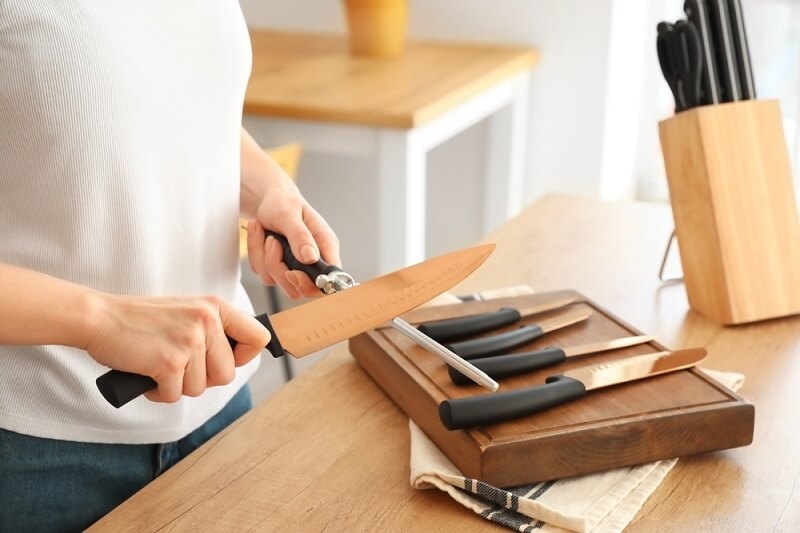
As beginner cooks, learning good knife skills is one of the best things a home cook can do to become more efficient and confident in the kitchen. Knowing how to hold a chef’s knife properly and practicing some basic chopping techniques will make cooking faster, safer, and more enjoyable. While using a knife like a pro takes time, establishing the fundamentals — grip, motion, balance, and care of the blade — will lay the foundation for every delicious meal you prepare.
Good knife skills are not just about cutting quickly; it is about control, precision, and safety. Whether you have your own slicing versus dicing guide to prepare your ingredients evenly or you are learning knife safety tips, this guide will take you through everything you need to be up and running.
Every cook, whether a beginner or an experienced one, uses proper knife technique. Acquiring good knife skills allows you to:
After all, good, even cuts of vegetables and perfectly sliced meat aren't just for show — they really do help every bite cook more evenly and maintain flavor balance.

First things first, before you even begin slicing and dicing, it’s essential to learn the correct way to hold a chef’s knife. A proper grip provides greater control, reduces fatigue, and ultimately decreases the likelihood of the knife slipping from your hand.
If you are not accustomed to cooking, you may have started by using the handle grip, holding the knife completely by the handle. The handle grip makes it feel more natural, but as you become more accustomed to the pinch grip, you will start to feel more stable and in control.
The more you use these grips, the more you will gain wrist control, and ultimately, every slice will become smoother and safer.
Once you are comfortable with the correct grip, you can move on to basic chopping techniques. Each technique is used for a specific reason and helps prepare an ingredient for the recipe it is intended for.
As you become more proficient, pay attention to maintaining even pressure and consistent motion. Always use a sharp knife and a flat, stable cutting surface.
Even the most seasoned chefs acknowledge a healthy respect for their knives. Following our knife safety practices will help you avoid injury and maintain a safe, clean, and organized workspace.
If you make safety a habit, you will be able to handle yourself without worry — and that is a significant step towards developing good knife skills as an inexperienced knife user.
A guide to slicing and dicing informs you on what cut to use for any recipe. Although the two cuts are similar, they serve different purposes in cooking.
Pro tip: You can dice by first slicing the food, then rotating the food, and cutting again into small cubes. The more you slice or dice, the better you will understand how the cut size will affect the texture and cooking time.
Regardless of your level of experience, dull knives will hinder your efficiency and safety. The following is a description of the sharpening process for kitchen knives, designed to keep your tools, specifically knives, in great shape.
Using sharpened knives will benefit you by making it easier to cut, lessening fatigue, and creating cleaner slices. Sharpening your knives is always an essential component for gaining knife skills as a novice and prolonging the life of your kitchen tools.
Regardless of your enthusiasm, even as a novice, you're likely to make minor errors that can have consequences for either safety or performance. Below are some traps to avoid:
Being aware of these 'bad habits' will help you improve your technique and experience smoother progress.
Chopping with a knife is a skill that will improve with practice. Start slowly, and practice for accuracy and technique. You can use potatoes, onions, and carrots to practice your chopping method and explore different ways of cutting. You will eventually develop fluid motion, and you will notice how using better technique increases enjoyment in the cooking experience. Minor adjustments to how you hold the chef’s knife or how you maintain a sharp blade can significantly improve your cooking experience.
To get started, you don’t need an entire knife set. A few versatile, high-quality knives can handle nearly any kitchen task.
Essential Knives for Starters
When choosing, consider comfort, balance, and weight. A well-fitting knife should feel like an extension of your hand, allowing for smooth motion and control.
Caring for your knives ensures they remain effective and safe for years to come. Beyond sharpening kitchen knives, proper storage and cleaning are equally important.
Regular care turns your knives into reliable kitchen partners, enhancing every cut and slice.
Mastering knife skills for beginners unlocks the door to a more confident and enjoyable cooking experience. By practicing how to hold a chef’s knife, learning basic chopping techniques, and following smart knife safety tips, you can handle ingredients with precision and ease. Keep your blades sharp and your skills sharper — every meal will taste better for it.
This content was created by AI